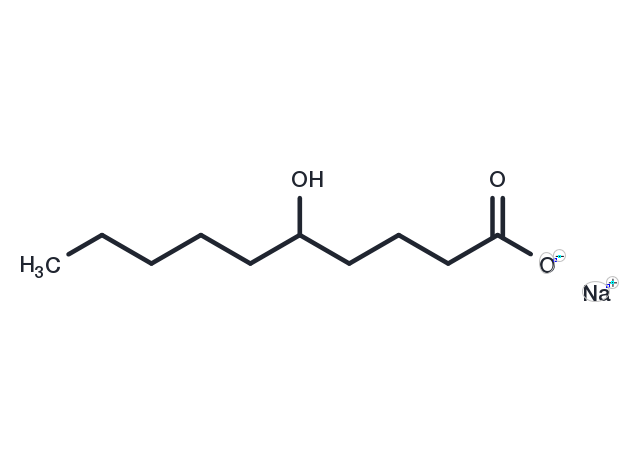Powder: -20°C for 3 years | In solvent: -80°C for 1 year


5-Hydroxydecanoate sodium is a selective ATP-sensitive K+ (KATP) channel blocker with IC50 of about 30 μM. 5-Hydroxydecanoate sodium is a substrate for mitochondrial outer membrane acyl-CoA synthetase with antioxidant property.

| Pack Size | Availability | Price/USD | Quantity |
|---|---|---|---|
| 10 mg | In stock | $ 33.00 | |
| 25 mg | In stock | $ 55.00 | |
| 50 mg | In stock | $ 97.00 | |
| 100 mg | In stock | $ 141.00 | |
| 200 mg | In stock | $ 209.00 | |
| 1 mL * 10 mM (in DMSO) | In stock | $ 61.00 |

| Description | 5-Hydroxydecanoate sodium is a selective ATP-sensitive K+ (KATP) channel blocker with IC50 of about 30 μM. 5-Hydroxydecanoate sodium is a substrate for mitochondrial outer membrane acyl-CoA synthetase with antioxidant property. |
| Targets&IC50 | K+-ATP channel:30 μM |
| In vitro | The treatment of 5-Hydroxydecanoate sodium abolished the beneficial effects of penehyclidine hydrochloride (PHC) preconditioning in anoxia/reoxygenation (A/R)‐induced injury in H9c2 cells. 5-Hydroxydecanoate sodium blocked the inhibitory effect of PHC on Ca2+ overload and ROS production and promoted the release of Cyt-C from mitochondria into cytoplasm. 5-Hydroxydecanoate sodium attenuated the anti-apoptotic effect of PHC[1]. |
| In vivo | The treatment of 5-Hydroxydecanoate sodium (100 μM) abolished the effects of ischemic preconditioning (IPC) on the contractile recovery, but 5-Hydroxydecanoate sodium did not affect its effect on the contracture, lactate production, glycogenolysis and viable tissue in rats[2]. |
| Molecular Weight | 210.25 |
| Formula | C10H19NaO3 |
| CAS No. | 71186-53-3 |
Powder: -20°C for 3 years | In solvent: -80°C for 1 year
DMSO: 3.6 mg/mL (17.12 mM)
You can also refer to dose conversion for different animals. More
bottom
Please see Inhibitor Handling Instructions for more frequently ask questions. Topics include: how to prepare stock solutions, how to store products, and cautions on cell-based assays & animal experiments, etc.
5-Hydroxydecanoate sodium 71186-53-3 Membrane transporter/Ion channel Potassium Channel 5 Hydroxydecanoate sodium 5Hydroxydecanoate sodium inhibitor inhibit
